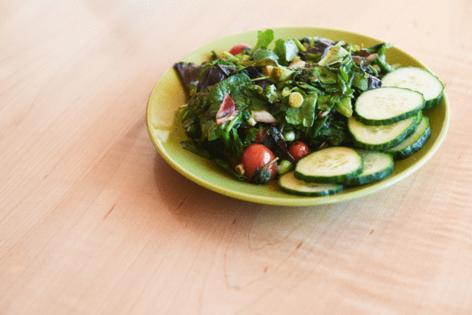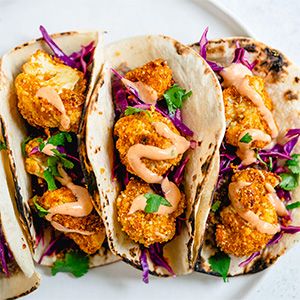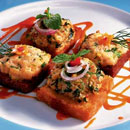This 3-course vegan meal is great for Vegetarian Awareness Month
Published in Variety Menu
I first tried Rasta pasta six years ago.
My friend was hosting her birthday party, a paint-and-sip night in Brooklyn. She is Jamaican and Nigerian, so I wasn't surprised to find the creamy Jamaican dish on the menu. When I had the first bite, I knew immediately that I would be getting seconds and maybe thirds. I was enticed.
The dish is a Jamaican play on Italian alfredo pasta. Think jerk seasoning, Scotch bonnet peppers, ginger and thyme. Right away, I wanted to understand how to replicate it in a way that suited my dietary needs as a vegetarian leaning toward veganism who also avoids dairy products.
It was in 2021, while dating a guy who is Jamaican by way of India and Costa Rica, that I first made the Jamaican pasta dish. About a month into getting to know one another, in an effort to be impressive, the words "I am great at making Rasta pasta" escaped my mouth — even though at that point I had only tasted it.
But I had a jerk seasoning recipe from a good college friend from the Virgin Islands, and I thought to myself: How hard could it be?
Surprisingly, it turned out amazing, and I have since dubbed myself a Rasta pasta expert and connoisseur. From my practice with vegetarian cooking, I believe it's because of the coconut milk.
October is Vegetarian Awareness Month, and as a flavorful introduction to this plant-based lifestyle, I tested a three-course vegan meal that sings the plant milk's praises.
Beyond its many nutritional benefits, coconut milk adds a subtle sweetness to cooking, making it the star of any dish. October to December is also peak season for coconut, so it's the throughline for the pasta dinner that starts with a spicy tom yum salad and concludes with no-bake coconut-chocolate doughnuts for dessert.
I know the three dishes may not seem like they go together but they actually do, as Thai and Caribbean food both have Indian influences.
There is a historical context to this through the migration — sometimes forced — of Indians to the Caribbean as indentured servants under the British between 1838 and 1920. This created an Indo-Caribbean influence that shows up in places like Trinidad and Tobago and Guyana and led to different foodways.
India also conducted trade with Southeast Asia, specifically Thailand, so it's not unusual to see roti and curries on both Caribbean and Thai menus.
When I looked at both flavor profiles, I understood that there was a nexus. Many of the ingredients in the bright tom yum salad, like ginger, lemon grass and garlic, could also translate to the Rasta pasta.
The original recipe for the salad calls for six Thai chiles, but if you're sensitive to spice, use fewer. I also added coconut oil to the salad dressing mix as a way to tie two foods that would not typically go together, and substituted Thai chiles for the (very hot) Scotch bonnet peppers typically called for in the pasta sauce. Both dishes are citrusy and extremely colorful.
For vegetarians and vegans alike, the meal is nutrient-dense, an important consideration when adopting a plant-based lifestyle. That includes the spring mix salad, which features the refreshing addition of mint, cilantro, tomatoes and lemon grass and is garnished with scallions.
Rasta pasta typically is used in a sauce made with heavy cream and butter, spinach and bell pepper, and mixed with chicken and shrimp. To make it vegan, I used portobello mushrooms instead, which have the same tender texture as meat. Sautéing the peppers first allows the mushrooms and shallots to soak up extra flavors.
To add the requisite spice, I used three types of jerk seasoning — Walkerswood jerk seasoning paste , a salt-free jerk seasoning blend from Penzeys Spices in the Strip District and dry rub Island Spice jerk seasoning — but you can also make your own personal blend. The heat in this dish is subtle because the coconut milk tones it down.
The no-bake coconut chocolate doughnuts served for dessert reemphasize the coconut flavor, both in the dough and the icing. I completely botched the round cakes on my first try, so I offer a small piece of advice: Do not go overboard on the coconut milk!
"As needed" can be quite subjective, but if you use too much as I did initially, you'll end up with a soupy dessert.
The end result was an unexpected pairing of flavors. But I feel it was a perfect way to enjoy a delicious Vegetarian Awareness Month.
Spicy Tom Yum Salad
PG tested
Vegan chili paste — I used the Thai Home brand — and brown sugar add a spicy-sweet kick to this salad dressing. A cucumber garnish tones down the heat.
For salad dressing
6 Thai chiles, finely chopped
2 tablespoons of minced garlic
1/4 cup brown sugar
2 tablespoons of lime juice
3 tablespoons of tamari or liquid aminos
1/2 teaspoon of salt
1 tablespoon vegan Thai sweet chili paste (nam prik pao) or sambal oelek chili paste
For salad
6 tablespoons finely sliced lemongrass
6 tablespoons of finely sliced kaffir lime leaves or lemon thyme
1 cup chopped cilantro
1 cup chopped mint leaves
8 grape tomatoes, halved
1 teaspoon vegetable or coconut oil
3 cups spring salad
1/3 cup of chopped scallions, for garnish
Sliced cucumber, for garnish
In a small bowl, whisk together the salad dressing ingredients until sugar is dissolved and mixture is smooth and well combined, about 5 minutes. Transfer to the refrigerator.
Place chopped lemongrass, lime leaves, cilantro and mint leaves in a large bowl with tomatoes and shallots. Toss with oil. Add spring salad mix to the bowl and toss the ingredients together.
Pour salad dressing over the mixture and gently toss to coat.
Divide on salad plates using tongs. Garnish with sliced scallions and sliced cucumber.
Serves 6.
— adapted from "Vegan Thai Kitchen" by Sarah Jansala with Rendo Jansala
Rasta Pasta
PG tested
I used Veggie Craft Rotini pasta, which is made of quinoa, cauliflower and lentils, all of which are a good source of iron for vegans and vegetarians.
You can buy jerk seasoning at a spice shop, Caribbean or Mexican market or on Amazon. You can also make a jerk seasoning at home with a blend with peppercorns, cayenne pepper, paprika, thyme, coriander, red pepper flakes, Scotch bonnet pepper, garlic, ginger, cumin, onion powder and salt and black pepper.
For pasta sauce
1 14-ounce can coconut milk
1/2 cup jerk seasoning blend
1/4 cup maple syrup or honey
1 tablespoon minced garlic
1 tablespoon vegetable oil
2 tablespoons cumin
1 tablespoon coriander
1 lemon, halved and squeezed, or 1/3 cup of lemon juice
1 bay leaf or sprig of thyme
1/4 cup lemon thyme
2 Thai chiles, chopped
For pasta
8 ounces dry pasta
1/3 cup olive oil
1 large red bell pepper
1 large green bell pepper
1 large yellow bell pepper
1 tablespoon minced garlic
1 shallot, chopped
2 cups chopped mushrooms
1/2 cup of frozen spinach cup or 1 cup of fresh spinach
1/2 teaspoon salt
1/2 teaspoon black pepper
1/3 cup chopped lemon grass, for garnish
1/2 cup of chopped scallions, for garnish
Place all sauce ingredients in a saucepan and bring to boil. Reduce to low heat and cook for 20 minutes, stirring occasionally. Once finished, keep warm on very low heat.
Meanwhile bring a pot of water to boil. Add pasta, and cook for 8 minutes, then drain and set aside in a large pot.
Heat oil in a saute pan, then add sliced peppers and cook until their color is still bright, but they have browned slightly and are aromatic. When cooked, chop and then add to the pot of pasta.
To the same saute pan, add garlic and shallots and saute until tender and aromatic, about 2 minutes.
Add chopped mushrooms and cook until they release their liquid. Then add spinach along with salt and pepper.
Once mushrooms are browned and tender, remove the mixture and add to pasta.
Pour warm sauce over the mixture, and toss to combine with a large spoon.
Place two scoops of pasta in a bowl, and top with sliced lemongrass and scallions.
Serves 6.
— Shaylah Brown, Post-Gazette
Coconut Chocolate Doughnuts
PG tested
This recipe is easy but takes some time. After shaping the dough into doughnuts, you'll need to place the rounds in the freezer for about 2 hours to set.
For doughnuts
1 cup oat flour
1 cup coconut flour, plus more for dusting
1/4 cup cacao or cocoa powder
2 tablespoons carob powder
1 pinch Himalayan salt
1 cup gooey, pitted dates
1/4 cup maple syrup
1 teaspoon vanilla extract
1/2 cup coconut milk
1/4 cup coconut oil, plus more for pan
For icing
1/4 cup maple syrup
1/4 cup coconut oil
1/4 cup almond butter
1/4 cup cacao powder
1/4 tablespoon vanilla extract
1/4 cup of coconut milk
Place oat and coconut flours, cacao and carob powders, salt, dates, maple syrup, vanilla and coconut milk in a food processor, and pulse at medium speed until combined. Gradually add in coconut oil until you get a smooth, dough-like consistency. If you do not have a food processor, chop dates very fine and mix in a bowl with other ingredients.
Place the mixture to the side while you make icing.
In blender, combine maple syrup, coconut oil, almond butter, cacao, vanilla extract and coconut milk and blend until smooth and creamy. Alternatively, mix the ingredients by hand in a bowl until you have a pourable consistency.
Line a baking sheet with parchment paper and lightly oil it with coconut oil.
Mold doughnut mixture into 4 small mounds, pressing in the center to create a hole, then place each doughnut on the baking sheet about 2 inches apart.
Place baking sheet in freezer and allow doughnuts to set for at least 2 hours, then remove from freezer and allow them to thaw (this should take about 30-45 minutes).
Pour icing into bowl, and dip doughnuts into icing to coat.
Transfer doughnuts to a dessert plate, top with slivered almonds and a dusting of coconut flour, and serve at room temperature.
Serves 4. — adapted from "The Ultimate Vegan Cookbook: The Must-Have Resource for Plant-Based Eaters" by Emily von Euw, Kathy Hester, Linda and Alex Meyer, Marie Reginato, Celine Steen and Amber St. Peter
©2025 PG Publishing Co. Visit at post-gazette.com. Distributed by Tribune Content Agency, LLC.










Comments